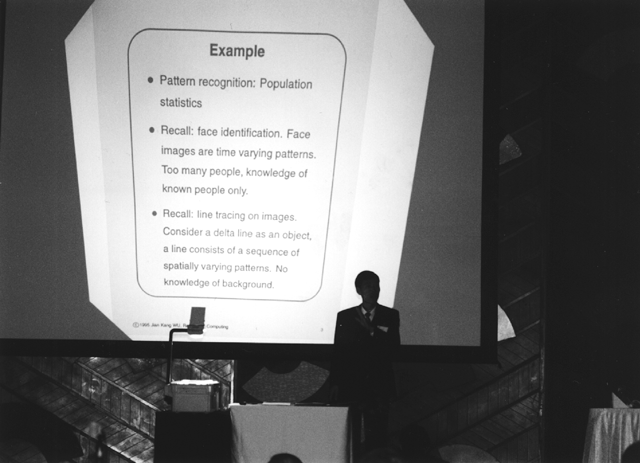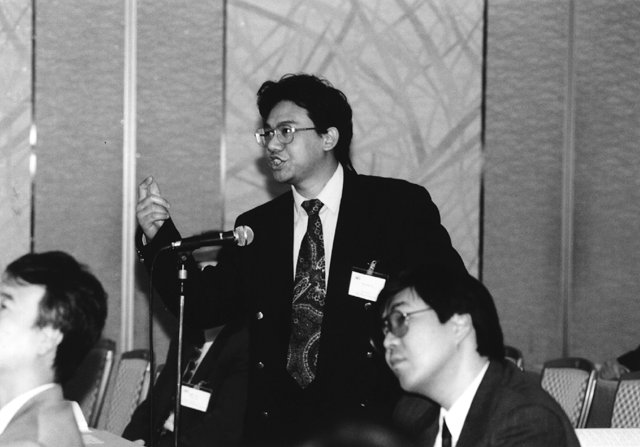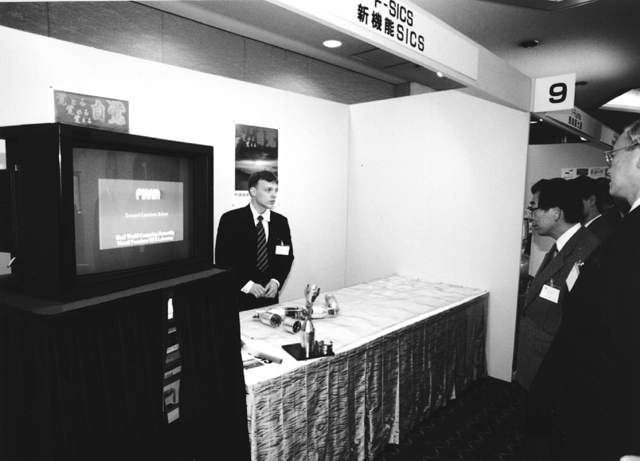
Oral presentation(Dr. J.K. Wu from ISS)
| Ryoji Suzuki Professor Matto Laboratories for Human Information Systems Kanazawa Institute of Technology |
The snow falling and accumulating in Hokuriku Area last night caused traffic jams in Kanazawa, so after taking a taxi, I arrived two hours late for the scheduled departure time at Komatsu Airport. When I finally arrived at the Hotel New Otani where the RWC Symposium was held, the afternoon oral presentations of Technical Sessions had already started. I hurriedly ran from the reception desk to Room B.

Oral presentation(Dr. J.K. Wu from ISS)
On the platform was Dr. Wu from ISS with an eager audience of about 40 people. He was talking about face recognition by calculating similarities to facial images recalled from memory, and stressed the closeness of this technology to the human method of face recognition, which is different from conventional technical classification with discriminant functions in feature space.
Dr. Arbuckle from Mitsubishi reported on the research results of their image recognition system developed over the last five years. He showed that the development of a general - purpose vision system, implemented in a modular architecture, had been conceived using such technological fields as fuzzy, competitive neural networks, and associative memory, based on the flexible recognition theory developed by Dr. Otsu at ETL, and a recognition rate of almost 100% had been obtained in experimental face recognition.

Q&A session promoted energetic discussions
After the oral presentations, I hurried to the intended demonstration site. Since I rushed into Room B, and had no time to look at the guidance brochure showing the layout of the booths, I couldn't find the location of the booth I wanted in the demonstration site. When I got close to one crowded booth, I noticed a massively parallel computer, the RWC-1. This was one of the cores of the RWC Project's achievements, and indeed the most popular. The EM-X booth of ETL was also crowded. I gave up trying to see their demonstrations this time and then looked for the Novel Functions booths. I hope to have a chance to see the functions of RWC-1 and EM-X next time.
I first stopped by the Fujitsu booth that was demonstrating a mobile robot system that had autonomous learning and growth functions. This robot moves based on an internal model of the environment, and detects differences of the model from the actual environment. Better navigation is possible by memorizing the difference and correcting the model after one cycle of navigation. These explanations were presented with a clear video. At the next booth, Dr. Nilsson from SICS demonstrated a snake robot which moved by bending its joints through reinforcement learning.

Demonstration of Snake Robot by Novel Functions SICS Lab.
The poster sessions were about to close at this time, so in fear of losing the chance to see any of them, I went there first. However, the prime time to see the poster sessions was already over with only a few visitors remaining. Fortunately, Dr. Hayashi from NTT was still in front of his poster. His theme was in reference to the neuromagnetic field evoked in the brain when vowels are heard. Dipoles are expected to be in order, aligned in a row on the temporal lobe for pure sounds and at positions equivalent to the second formant frequency for vowels. This is basic research with a long distance to go when compared to other research. However, a feasibility study indicates the importance of clarifying this computational algorithm in the brain. It would be beneficial if magnetoencephalography (MEG) could be applied to humans. To what degree can we find out the functions of the brain with it? It is important to properly know the role of the MEG.
I passed the posters with no presenters and went back to the demonstration site, because I felt that the information in the posters would be almost the same as the information in the Proceedings.
I visited the demonstration booths again in numbered order, starting from Booth 1. I cannot report on all of the booths here, but I gained the impression that interaction with machines had achieved a practical stage with the combination of verbal and non-verbal symbols such as gestures and facial expressions as found in the electronic secretary supporting cooperation by the Tsukuba Research Center, the sign language translation by Hitachi, and the multimodal interface by ETL and Sharp.
At Booth 7, Dr. Aso from ETL showed how the mobile robot learns by remotely controlling this robot which was distantly located in the corridor of ETL in Tsukuba.
Of the robot sessions on the following day in Room A, the Contact Interaction Robot by Prof. Sato from the University of Tokyo, the Hand to Hand Robot by Dr. Suehiro at RWC, and the mobile robot by Dr. Watanabe from Fujitsu were interesting to me.
After hearing the presentation on speech understanding by Prof. Fischer from University of Erlangen, there was a coffee break and I moved to Room B, where I heard a presentation on sign language recognition by Dr. Sagawa from Hitachi and one on self-organized information space by Mitsubishi. Then I had to leave there to be present at the regional conference entitled "Intelligence and Synthesis" of PRESTO (Precursory Research for Embryonic Science and Technology) held in Hayama.
From my visit to the RWC '97, I was impressed by the technological advances that have been made in the last five years that integrate various modes of communication that humans take for granted, such as natural languages, facial expressions, and gestures. We may also say that the movements of mobile and working robots have come closer, bit by bit, to human capability. In the background, theories for solving ill-posed problems have been put into practice. However, I felt that the technology is still awkward when faced to the complexity of the real world. How can we overcome this challenge?
At the regional conference on "Intelligence and Synthesis," problems like "Knowledge and Wisdom," "Autonomy and Consciousness," and "DNA and Intelligence" were chosen as discussion topics, which were not dealt with even in biology. Unfortunately, the gap is still too big to handle with our present technology. However, if the secret of how organic bodies behave well in the complex world could be revealed through such discussions, it might be transferred to technology some day. I spent three days in Hayama with such dreams, and expected to challenge the complexity in the second half period of RWC Project.